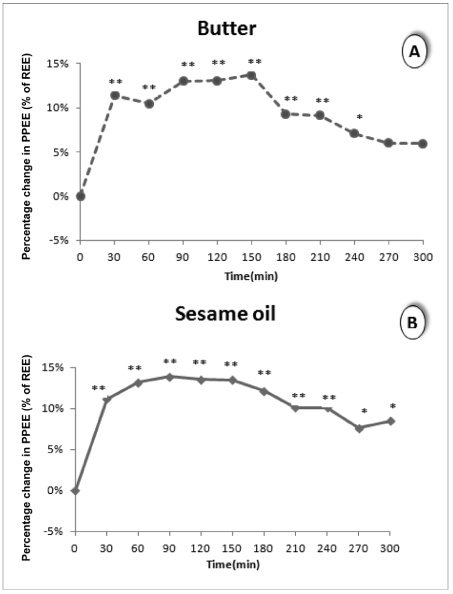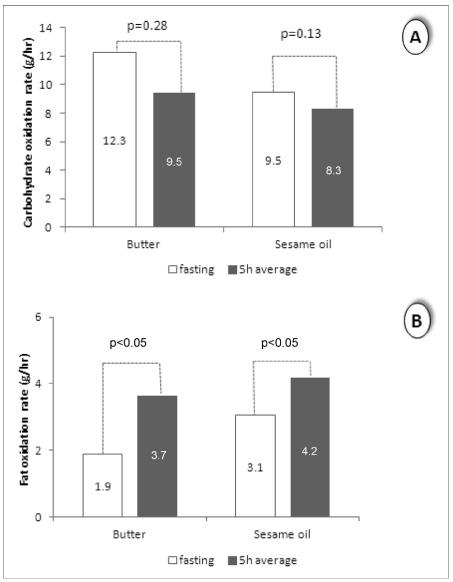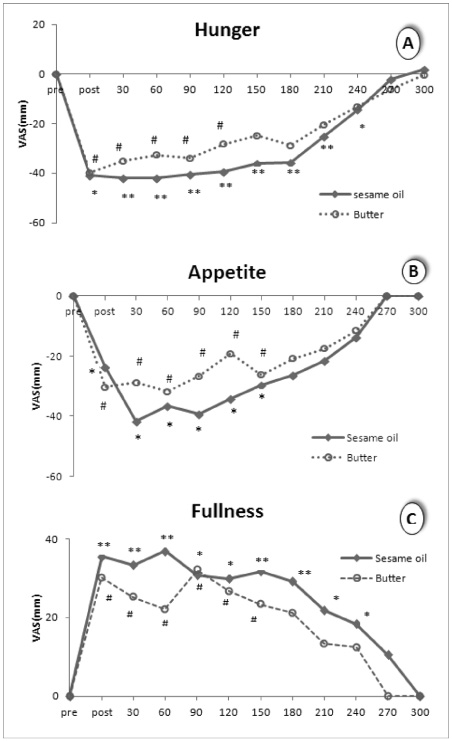Korean J Community Nutr.
2012 Apr;17(2):215-225. 10.5720/kjcn.2012.17.2.215.
Thermic Effect of Food, Macronutrient Oxidation Rate and Satiety of High-fat Meals with Butter and Sesame Oil on Healthy Adults
- Affiliations
-
- 1Department of Food and Nutrition, Gangneung-Wonju National University, Gangneung, Korea. ekkim@gwnu.ac.kr
- KMID: 2267398
- DOI: http://doi.org/10.5720/kjcn.2012.17.2.215
Abstract
- The purpose of this study was to measure and investigate the acute effects of two fatty meals (high-SFA & high-PUFA) on post-prandial thermic effect, substrate oxidation, and satiety. Eight healthy adults (four males and four females) aged 19-22 years were assigned to consume two isocaloric meals: high in saturated fatty acids from butter and high in polyunsaturated fatty acids from sesame oil. Indirect calorimetry was used to measure resting energy expenditure (REE), post-prandial energy expenditure for five hours, and substrate oxidation. Satiety of the subjects after meals was estimated by using visual analogue scales (VAS). Five hours thermic effect of food (TEF) was not significantly different between butter meal (6.5% of energy intake) and sesame oil meal (7.3% of energy intake), but, the TEF of butter meal reached the peak point at 150 min and decreased more rapidly arriving to REE in 270 min. On the other hand, TEF of sesame oil meal reached the peak at 90 min and decreased slower than butter meal (still higher than REE at 300 min). No significant differences in substrate oxidation rates were found between the two meals. Post-prandial fat oxidation rates increased significantly after the consumption of both butter and sesame oil meal than that of the pre-prandial state. Satiety values (hunger, fullness, and appetite) were similar among the meals, but recovery of hunger and fullness to the pre-prandial state was faster in butter meal than that of the sesame oil meal.
Keyword
MeSH Terms
Figure
Reference
-
1. Acheson KJ. Influence of autonomic nervous system on nutrient-induced thermogenesis in humans. Nutrition. 1993. 9(4):373–380.2. Alper CM, Mattes RD. Effects of chronic peanut consumption on energy balance and hedonics. Int J Obes Relat Metab Disord. 2002. 26(8):1129–1137.3. Blundell JE, Rogers PJ. Friedman MI, Tordoff MG, Kare MR, editors. Hunger, hedonics and the control of satiation and satiety. Chemical Senses: Appetite and Nutrition. 1991. New York: Marcel Dekker Inc;127–148.4. Blundell JE, MacDiarmid JI. Fat as a risk factor for overconsumption: satiation, satiety, and patterns of eating. J Am Diet Assoc. 1997. 97:7 Suppl. S63–S69.5. Casas-Agustench P, López-Uriarte P, Bulló M, Ros E, Gómez-Flores A, Salas-Salvadó J. Acute effects of three high-fat meals with different fat saturations on energy expenditure, substrate oxidation and satiety. Clin Nutr. 2009. 28(1):39–45.6. Cecil JE, Francis J, Read NW. Comparison of the effects of a high-fat and high-carbohydrate soup delivered orally and intragastrically on gastric emptying, appetite, and eating behaviour. Physiol Behav. 1999. 67(2):299–306.7. Claessens M, van Baak MA, Monsheimer S, Saris WH. The effect of a low-fat, high-protein or high-carbohydrate ad libitum diet on weight loss maintenance and metabolic risk factors. Int J Obes (Lond). 2009. 33(3):296–304.8. Clarke SD, Gasperikova D, Nelson C, Lapillonne A, Heird WC. Fatty acid regulation of gene expression: a genomic explanation for the benefits of the mediterranean diet. Ann N Y Acad Sci. 2002. 967:283–298.9. De Graaf C, Blom WA, Smeets PA, Stafleu A, Hendriks HF. Biomarkers of satiation and satiety. Am J Clin Nutr. 2004. 79(6):946–961.10. DeLany JP, Windhauser MM, Champagne CM, Bray GA. Differential oxidation of individual dietary fatty acids in humans. Am J Clin Nutr. 2000. 72(4):905–911.11. Dubois D, Dubois EF. The measurements of the surface area of man. Arch Intern Med. 1915. 15:868–881.12. Granata GP, Brandon LJ. The thermic effect of food and obesity; discrepant results and methodological variations. Nutr Rev. 2002. 60(8):223–233.13. Delaš Ivančica. Benefits and hazards of fat-free diets. Trends in Food Science & Technology. 2011. 22(10):576–582.14. Jones PJ, Pencharz PB, Clandinin MT. Whole body oxidation of dietary fatty acids: implications for energy utilization. Am J Clin Nutr. 1985. 42(5):769–777.15. Katan MB, Grundy SM, Willett WC. Should a low-fat, high-carbohydrate diet be recommended for everyone? Beyond low-fat diets. N Engl J Med. 1997. 337:563–567.16. Kien CL, Bunn JY. Gender alters the effects of palmitate and oleate on fat oxidation and energy expenditure. Obesity (Silver Spring). 2008. 16(1):29–33.17. Kim MH, Kim EK. Thermic Effect of Food and macronutrient oxidation rate in men and women after consumption of a mixed meal. Korean J Nutr. 2011. 44(6):507–517.18. Kinabo JL, Durnin JV. Thermic effect of food in man: effect of meal composition, and energy content. Br J Nutr. 1990. 64(1):37–44.19. Labayen I, Forga L, Martínez JA. Nutrient oxidation and metabolic rate as affected by meals containing different proportions of carbohydrate and fat, in healthy young women. Eur J Nutr. 1999. 38(3):158–166.20. Lawton CL, Delargy HJ, Brockman J, Smith FC, Blundell JE. The degree of saturation of fatty acids influences post-ingestive satiety. Br J Nutr. 2000. 83(5):473–482.21. Maffeis C, Schutz Y, Grezzani A, Provera S, Piacentini G, Tatò L. Meal-induced thermogenesis and obesity: is a fat meal a risk factor for fat gain in children? J Clin Endocrinol Metab. 2001. 86(1):214–219.22. Marrades MP, Martínez JA, Moreno-Aliaga MJ. Differences in short-term metabolic responses to a lipid load in lean (resistant) vs obese (susceptible) young male subjects with habitual high-fat consumption. Eur J Clin Nutr. 2007. 61(2):166–174.23. Matsuo T, Shimomura Y, Saitoh S, Tokuyama K, Takeuchi H, Suzuki M. Sympathetic activity is lower in rats fed a beef tallow diet than in rats fed a safflower oil diet. Metabolism. 1995. 44(7):934–939.24. Matthews JN, Altman DG, Campbell MJ, Royston P. Analysis of serial measurements in medical research. BMJ. 1990. 300(6719):230–235.25. Mercer SW, TrayHurn P. Effect of high fat diets on the thermogenic activity of brown adipose tissue in cold-acclimated mice. J Nutr. 1984. 114:1151–1158.26. Ministry of Health and Welfare. Korea Health Statistics 2010: Korea National Health and Nutrition Examination Survey (KNHANES V-1). 2011.27. Péronnet F, Massicotte D. Table of nonprotein respiratory quotient: an update. Can J Sport Sci. 1991. 16(1):23–29.28. Piers LS, Walker KZ, Stoney RM, Soares MJ, O'Dea K. The influence of the type of dietary fat on postprandial fat oxidation rates: monounsaturated (olive oil) vs saturated fat (cream). Int J Obes Relat Metab Disord. 2002. 26(6):814–821.29. Raben A, Agerholm-Larsen L, Flint A, Holst JJ, Astrup A. Meals with similar energy densities but rich in protein, fat, carbohydrate, or alcohol have different effects on energy expenditure and substrate metabolism but not on appetite and energy intake. Am J Clin Nutr. 2003. 77(1):91–100.30. Reed GW, Hill JO. Measuring the thermic effect of food. Am J Clin Nutr. 1996. 63(2):164–169.31. Ro HK, Choi IS, Oh SH. Effects of high carbohydrate, high fat and protein meal on postprandial thermogenesis in young women. J Korean Soc Food Sci Nutr. 2005. 34(8):1202–1209.32. Rumpler WV, Baer DJ, Rhodes DG. Energy available from corn oil is not different than that from beef tallow in high- or low-fiber diets fed to humans. J Nutr. 1998. 128(12):2374–2382.33. Schutz Y, Bessard T, Jéquier E. Diet-induced thermogenesis measured over a whole day in obese and nonobese women. Am J Clin Nutr. 1984. 40(3):542–552.34. Segal KR, Edaño A, Blando L, Pi-Sunyer FX. Comparison of thermic effects of constant and relative caloric loads in lean and obese men. Am J Clin Nutr. 1990. 51(1):14–21.35. Soares MJ, Cummings SJ, Mamo JC, Kenrick M, Piers LS. The acute effects of olive oil v. cream on postprandial thermogenesis and substrate oxidation in postmenopausal women. Br J Nutr. 2004. 91(2):245–252.36. Storlien LH, Huang XF, Lin S, Xin X, Wang HQ, Else PL. Dietary fat subtypes and obesity. World Rev Nutr Diet. 2001. 88:148–154.37. Takeuchi H, Matsuo T, Tokuyama K, Shimomura Y, Suzuki M. Diet-induced thermogenesis is lower in rats fed a lard diet than in those fed a high oleic acid safflower oil diet, a safflower oil diet or a linseed oil diet. J Nutr. 1995. 125(4):920–925.38. Tentolouris N, Pavlatos S, Kokkinos A, Perrea D, Pagoni S, Katsilambros N. Diet-induced thermogenesis and substrate oxidation are not different between lean and obese women after two different isocaloric meals, one rich in protein and one rich in fat. Metabolism. 2008. 57(3):313–320.39. The Korean Nutrition Society. Dietary reference intakes for Koreans. 2010. 1st revision. Seoul:40. Weir JB. New methods for calculating metabolic rate with special reference to protein metabolism. J Physiol. 1949. 109(1-2):1–9.41. Wellman NS, Friedberg B. Causes and consequences of adult obesity: health, social and economic impacts in the United States. Asia Pac J Clin Nutr. 2002. 11(Suppl 8):S705–S709.42. Weststrate JA. Resting metabolic rate and diet-induced thermogenesis :a methodological reappraisal. Am J Clin Nutr. 1993. 58:592–601.43. Westerterp KR. Diet induced thermogenesis. Nutr Metab (Lond). 2004. 1(1):5.44. WHO Expert Consultation. Appropriate body-mass index for Asian populations and its implications for policy and intervention strategies. Lancet. 2004. 363:157–163.
- Full Text Links
- Actions
-
Cited
- CITED
-
- Close
- Share
- Similar articles
-
- Thermic Effect of Food, Macronutrient Oxidation Rate and Satiety of Medium-chain Triglyceride
- Thermic Effect of Food and Macronutrient Oxidation Rate in Men and Women after Consumption of a Mixed Meal
- Effects of Sesame Oil on the Reproductive Parameters of Diabetes Mellitus-Induced Male Rats
- Short-Term Effect of Convenience Meal Intake on Glycemic Response and Satiety among Healthy College Students in South Korea
- Effects of macronutrients in mixed meals on postprandial glycemic response





